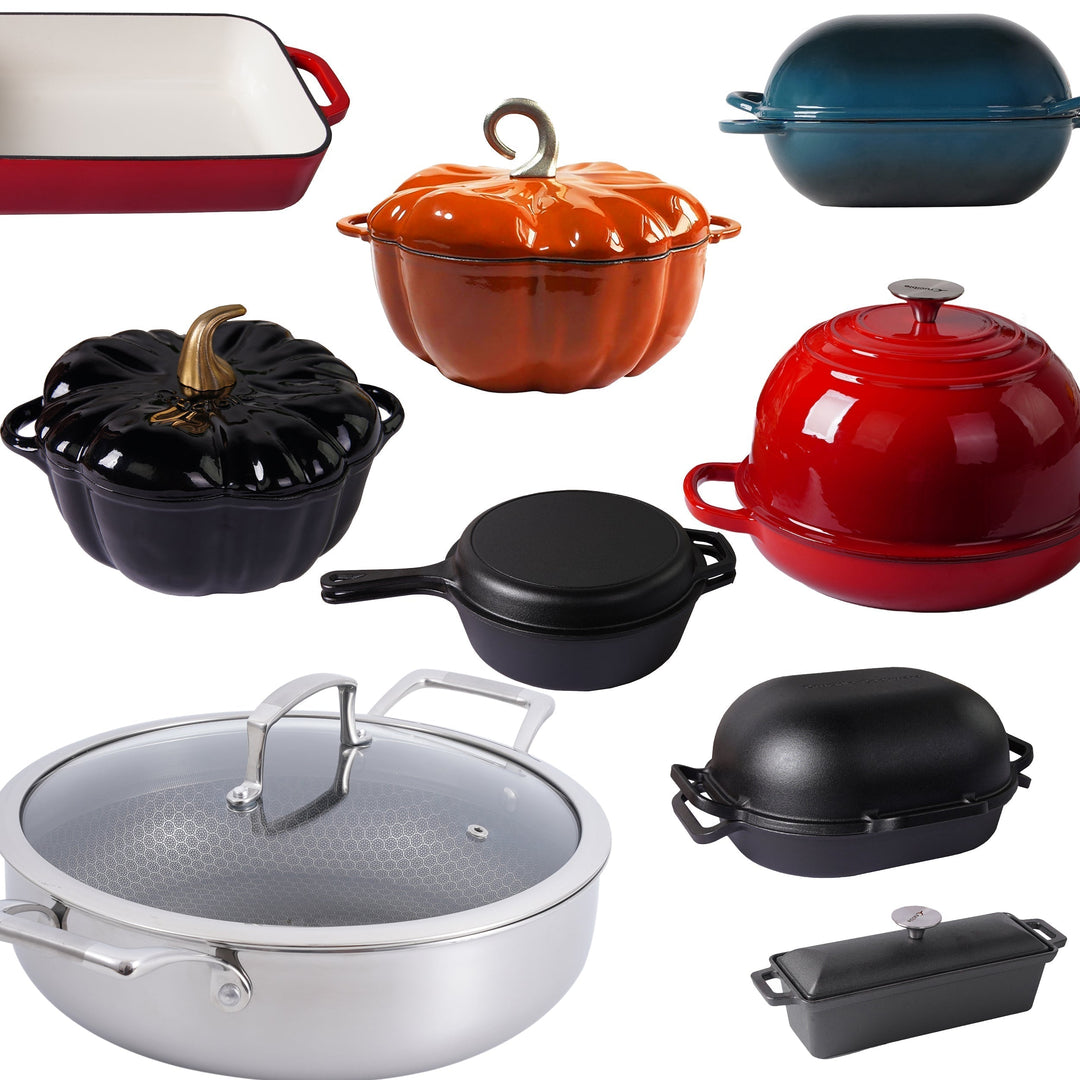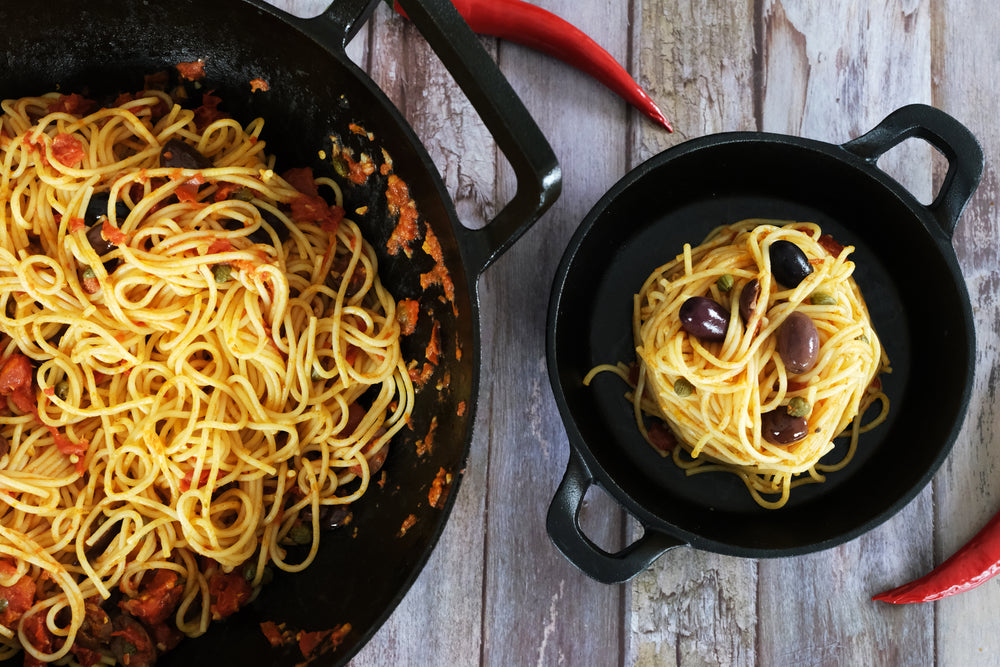Videnskaben bag Indbrænding af støbejernsgryder: Myter, metoder og vedligeholdelse

For dem, der elsker at lave mad, er støbejernsgryder og -pander et køkkenfavorit på grund af deres holdbarhed, alsidighed og den rige smag, de kan tilføre retter. Et emne, der dog ofte vækker debat, er, hvordan man korrekt indbrænder og vedligeholder disse klassiske pander. Fra modstridende råd om olier til forskellige opvarmningsteknikker, er der mange misforståelser om indbrænding af støbejern. I dette indlæg dykker vi ned i videnskaben bag indbrænding, afkræfter almindelige myter og giver idiotsikre trin til at holde dit støbejernsudstyr i topform i mange år frem.
Hvad Betyder Det at Indbrænde Støbejern?
At "indbrænde" støbejern betyder at skabe et beskyttende lag af polymeriseret olie, der binder sig til pandens overflade. Dette lag opbygges over tid og tjener flere vigtige formål:
- Non-stick overflade: Korrekt indbrænding danner et glat, non-stick lag, der gør det nemt at vende pandekager, stege bøffer og sautere grøntsager uden at det hænger fast.
- Rustforebyggelse: Støbejern er modtageligt for rust, hvis det udsættes for fugt. Indbrænding fungerer som en barriere, der beskytter jernet mod vand og oxidation.
- Smagsudvikling: Indbrænding kan over tid tilføre en unik smagsprofil, hvilket er grunden til, at mange kokke værdsætter godt indbrændte pander.
Videnskaben bag indbrænding
Indbrænding er en proces kaldet polymerisering, hvor olie opvarmes ud over sit røgpunkt, hvilket får den til at nedbrydes og binde sig til jernet. Når dette sker, gennemgår fedtsyrerne i olien en kemisk reaktion, der danner et glat, hårdt lag. Nøglen er at opbygge dette lag gradvist, så det hæfter jævnt og danner en solid, non-stick belægning.
De ideelle olier til indbrænding har en høj koncentration af umættede fedtstoffer, som er mere tilbøjelige til at polymerisere. Nogle af de bedste valg inkluderer:
- Hørfrøolie
- Druekerneolie
- Solsikkeolie
- Rapsolie
Disse olier nedbrydes hurtigt ved høje temperaturer, hvilket sikrer, at de binder ordentligt til jernoverfladen.
Afkræftelse af almindelige myter om indbrænding
Myte 1: Du bør kun bruge én type olie
Selvom hørfrøolie er populær for sin høje polymeriseringsevne, behøver du ikke kun bruge én type. Nøglen er at bruge olier med et højt røgpunkt, men du kan eksperimentere med druekerne-, raps- eller solsikkeolie til indbrænding. Hver olie har sine fordele og kan bruges ombytteligt, så længe du opretholder ensartet varme og varighed.
Myte 2: En blank pande er et tegn på en godt indbrændt pande
Ikke nødvendigvis. En korrekt indbrændt pande vil have en mat, sort finish. En blank overflade kan indikere, at indbrændingen ikke har sat sig ordentligt, eller at panden er blevet overolieret. Målet er et glat, ensartet lag, der føles næsten som en blød patina, når du kører hånden over det.
Myte 3: Sæbe vil ødelægge din indbrænding
Det er en almindelig opfattelse, at brug af sæbe på en støbejernspande vil fjerne indbrændingen, men det er ikke sandt. Moderne opvaskemidler er ikke så hårde som tidligere og vil ikke fjerne et godt bundet indbrændingslag. Undgå dog at bruge slibende svampe eller ståluld, da de kan ridse overfladen.
Trin-for-trin guide til indbrænding af dit støbejern
Klar til at give dit støbejern lidt kærlighed? Her er en gennemprøvet metode til at indbrænde din pande:
-
Rengør panden grundigt: Start med at skrubbe panden med varmt, sæbevand. Brug en børste eller en ikke-slibende svamp til at fjerne gamle madrester. Tør den helt med en fnugfri klud eller papirhåndklæde.
-
Forvarm ovnen: Forvarm din ovn til 450°F (230°C). Placer panden i ovnen i cirka 10 minutter for at sikre, at den er helt tør og forvarmet.
-
Påfør et tyndt lag olie: Brug en papirserviet eller klud til at gnide en lille mængde af din valgte olie over hele pandens indvendige og udvendige overflader. Sørg for at dække jævnt, og brug derefter et rent håndklæde til at tørre overskydende olie af. Panden skal se næsten tør ud, når du er færdig.
-
Bag panden: Placer panden med bunden opad på midterste rille i ovnen. Læg et stykke aluminiumsfolie eller en bageplade på den nederste rille for at opsamle dryp. Bag panden i 1 time ved 450°F.
-
Afkøl og gentag: Sluk ovnen og lad panden køle af indeni. For bedste resultat, gentag denne proces 2-3 gange for at opbygge et stærkt indbrændingslag.
Vedligeholdelse af din indbrænding
Indbrænding er ikke en engangsproces. Over tid kan tilberedning af sure fødevarer, brug af hårde rengøringsmetoder eller forsømmelse af regelmæssig oliering slide laget ned. Her er hvordan du holder dit støbejern i topform:
- Efter hver brug: Skyl panden med varmt vand og en ikke-slibende skrubber. Hvis der er genstridige rester, lad lidt vand simre i panden for at løsne dem.
- Tør straks: Tør altid panden grundigt efter vask. Stil den på komfuret ved lav varme for at fordampe eventuel resterende fugt.
- Smør let med olie: Efter hver brug påføres et meget tyndt lag olie på pandens inderside, mens den stadig er varm. Dette hjælper med at vedligeholde indbrændingen og forhindre rust.
Fejlfinding: Hvad hvis min pande ruster?
Rust kan dannes, hvis støbejern efterlades fugtigt for længe, eller hvis indbrændingslaget slides ned. Hvis du ser rustpletter, skal du ikke bekymre dig – det kan fixes!
- Skrub det rustne område med ståluld, indtil rusten er væk.
- Vask panden grundigt med sæbe og vand.
- Tør helt og genindbrænd efter ovenstående trin.
Afsluttende tanker
Med lidt omhu kan dit støbejernsudstyr blive et af de mest pålidelige redskaber i dit køkken. At forstå videnskaben bag indbrænding hjælper med at afmystificere processen og sikrer, at du behandler din pande korrekt. Husk, nøglen er at opbygge indbrændingen langsomt, være konsekvent med vedligeholdelsen og nyde de rige, smagfulde retter, som kun støbejern kan skabe.
Hvis du husker disse tips, får du en pande, der fungerer som en professionel – og som også ser fantastisk ud! God madlavning!
















Efterlad en kommentar